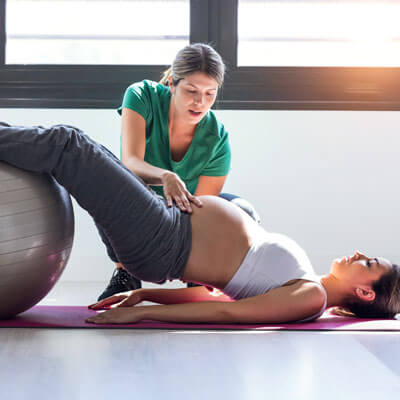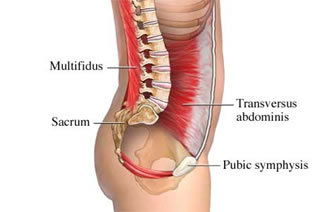 First and foremost, check with your doctor to ensure that it is safe for you to exercise.
First and foremost, check with your doctor to ensure that it is safe for you to exercise.
Some contraindications to exercise are the following:
- Musculoskeletal injuries
- Acute illness
- Vaginal bleeding (not period)
- Continuous nausea and vomiting
- Sudden onset of a new, lower abdominal or pelvic pain
- Musculoskeletal birth injury
- Epidural side effects
- Prolapse
We’ll start by talking about the core. The core is your diaphragm to your pelvic floor and all the muscles in between.
There are two different types of breathing that will help to stabilize the core and ensure you are getting the perfect amount of oxygen to your body.
 Diaphragm Breathing is also referred to as abdominal or belly breathing. To do this you will inhale through the nose to expand and fill up 360 degrees around the bottom ribs, belly and back. Then exhale to allow everything to return to neutral. This should be effortless. The belly has movement priority over the chest AND the chest still needs to move as does the back, scapula and most importantly, the rib cage. Chest breathers or only belly breathers will more likely to have core and/or pelvic floor dysfunction present and/or the inability to down regulate their nervous system.
Diaphragm Breathing is also referred to as abdominal or belly breathing. To do this you will inhale through the nose to expand and fill up 360 degrees around the bottom ribs, belly and back. Then exhale to allow everything to return to neutral. This should be effortless. The belly has movement priority over the chest AND the chest still needs to move as does the back, scapula and most importantly, the rib cage. Chest breathers or only belly breathers will more likely to have core and/or pelvic floor dysfunction present and/or the inability to down regulate their nervous system.
Stability Breathing is sometimes called Task Specific, Intra-abdominal Pressure breathing. As the diaphragm descends, it compresses the abdominal contents; the pelvic floor and abdominal wall eccentrically and activates in opposition to the force. The amount of IAP is task specific and meets its demand. For instance, picking up a pillow off the ground as opposed to picking up 300lb barbell.
Practice by “bracing”. Think about how you would engage your core if someone was going to punch you in the belly or if you’re going to lift something heavy. Suck your belly button to your spine or pull your pelvic floor all the way up. You brace out. You maintain expansion. Your internal pressure system is activated and ready to protect your spine and organs.
Basic exercises you can perform include:
Happy baby- this is intended to give a baseline breathing pattern
Dead bug – arms only, opposite arm + opposite leg, same arm + same leg, arms together + legs together. This is intended to provide stability
Side plank – on elbow or hand, on elbow + kickstand, on hand + kick stand. This is intended to provide shoulder and pelvic floor stability.
Oblique sit – This is intended to provide shoulder, hip and core stability and integrity.
Shin box – For active and passive hip range of motion
Table top – For core, hip and shoulder stability.
Segmental cat-cow – For spinal segmental, lumbar spine and thoracic spine motion and health.
Bird dog – For core, shoulder, and hip stability.
Tripod – For core, shoulder, and hip stability.
Squat – For hip and spine range of motion and stability.
Bear – For hip, spine and shoulder range or motion and stability.
Stand – Awareness of space.
Neck range of motion -For cervical spine curve and health.
Shoulder range of motion – For shoulder joints and biomechanical health.
Hip range of motion – For hip joint and biomechanical health.
Pelvic tilting on exercise ball – For hip and pelvis range of motion.
Figure 8 on exercise ball – For hip and pelvis range of motion.
Rebozo sifting – For abdominal muscle health.
